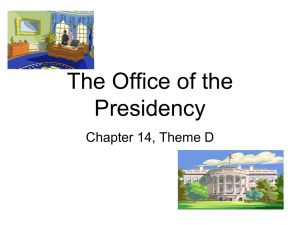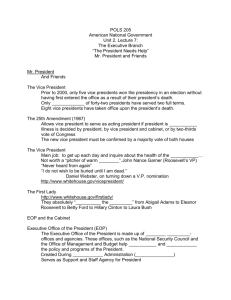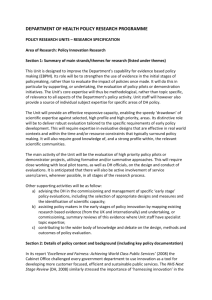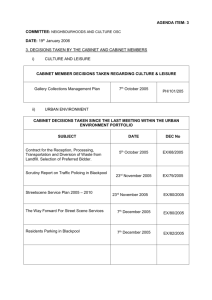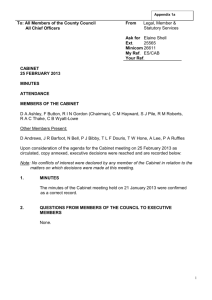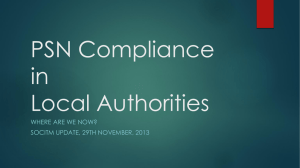POLS 205 American National Government Unit 2, Lecture 7: The
advertisement
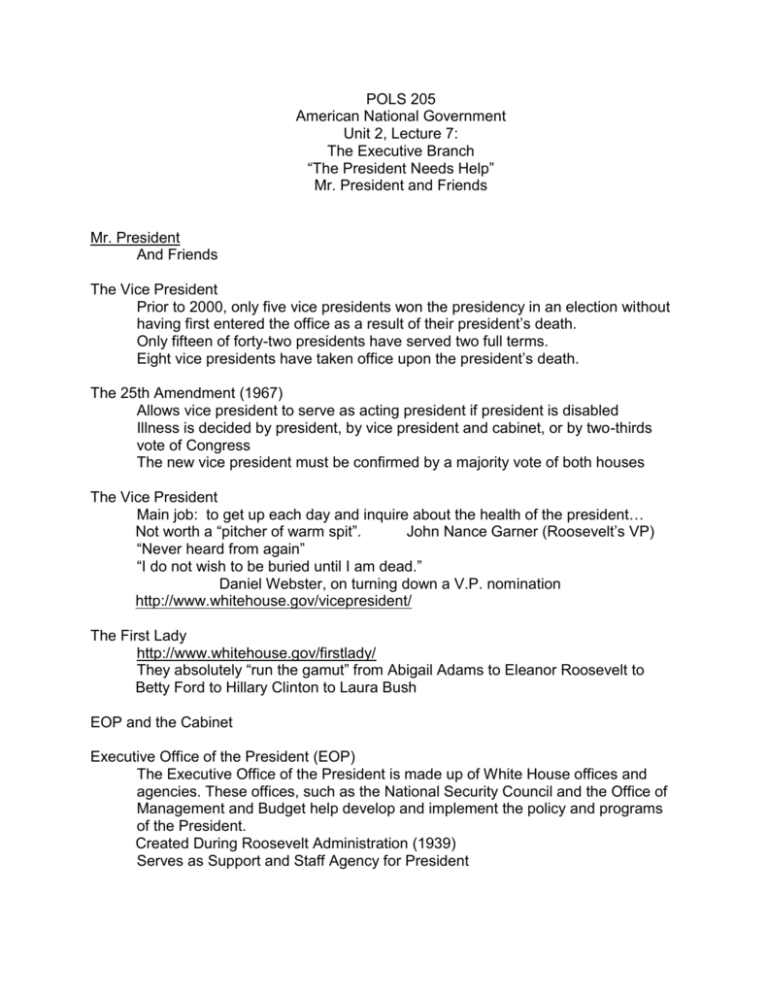
POLS 205 American National Government Unit 2, Lecture 7: The Executive Branch “The President Needs Help” Mr. President and Friends Mr. President And Friends The Vice President Prior to 2000, only five vice presidents won the presidency in an election without having first entered the office as a result of their president’s death. Only fifteen of forty-two presidents have served two full terms. Eight vice presidents have taken office upon the president’s death. The 25th Amendment (1967) Allows vice president to serve as acting president if president is disabled Illness is decided by president, by vice president and cabinet, or by two-thirds vote of Congress The new vice president must be confirmed by a majority vote of both houses The Vice President Main job: to get up each day and inquire about the health of the president… Not worth a “pitcher of warm spit”. John Nance Garner (Roosevelt’s VP) “Never heard from again” “I do not wish to be buried until I am dead.” Daniel Webster, on turning down a V.P. nomination http://www.whitehouse.gov/vicepresident/ The First Lady http://www.whitehouse.gov/firstlady/ They absolutely “run the gamut” from Abigail Adams to Eleanor Roosevelt to Betty Ford to Hillary Clinton to Laura Bush EOP and the Cabinet Executive Office of the President (EOP) The Executive Office of the President is made up of White House offices and agencies. These offices, such as the National Security Council and the Office of Management and Budget help develop and implement the policy and programs of the President. Created During Roosevelt Administration (1939) Serves as Support and Staff Agency for President Key Components White House Office Headed by Chief of Staff Office of Management and Budget National Security Council President, VP, Secretary of State, Secretary of Defense National Security Advisor – Council of Economic Advisors Office of National Drug Control Policy From the Whitehouse Website: http://www.whitehouse.gov/administration/eop/ THE EOP and the Whitehouse Offices The EOP Big Three: If you can’t run with the big dogs… The White House Staff http://www.whitehouse.gov/administration/staff/rahm_emanuel/ Office of Management and Budget http://www.whitehouse.gov/omb/ Established 1970 (Replaced Bureau of Budget) Prepares the President's Recommended Budget Administers the Annual Budget National Security Council Established 1947 Truman and the Cold War NSA and CIA created by National Security Act Coordinates Military and Foreign policies Department of State, Department of Defense, NSA, sometimes CIA and more How do you organize it? Circles and Pyramids: Free-flow, Gate-keepers and Ad-Hoc White House Office Rule of propinquity: power is wielded by people who are in the room when a decision is made Pyramid structure: most assistants report through hierarchy to chief of staff, who then reports to president Eisenhower, Nixon, Reagan, Bush, Clinton (late in his administration) Circular structure: cabinet secretaries and assistants report directly to the president Carter (early in his administration) Ad hoc structure: task forces, committees, and informal groups deal directly with president Clinton (early in his administration) Presidential Cabinets Not Just for Kitchens! The First Cabinet Washington and his cabinet: left to right, President Washington, Secretary of War Henry Knox, Secretary of the Treasury Alexander Hamilton, Secretary of State Thomas Jefferson, and Attorney General Edmund Randolph Cabinet Organization Heads of Major Executive Branch Agencies Includes 14 Department Secretaries and Attorney General President May Assign Cabinet Rank to Others The Cabinet Not explicitly mentioned in Constitution Presidents have many more appointments to make than do prime ministers, due to competition created by the separation of power Presidential control over departments remains uncertain—secretaries become advocates for their departments The tradition of the Cabinet dates back to the beginnings of the Presidency itself. One of the principal purposes of the Cabinet (drawn from Article II, Section 2 of the Constitution) is to advise the President on any subject he may require relating to the duties of their respective offices. Of course, the modern Cabinet just happens to have another “day job”… The Cabinet includes the Vice President and, by law, the heads of 15 executive departments: The Secretaries of Agriculture, Commerce, Defense, Education, Energy, Health and Human Services, Homeland Security, Housing and Urban Development, Interior, Labor, State, Transportation, Treasury, and Veterans Affairs, and the Attorney General make up the cabinet. Under President Barack Obama, Cabinet-level rank also has been accorded to the Chair, Council of Economic Advisors; Administrator, Environmental Protection Agency; Director, Office of Management and Budget; the U.S. Trade Representative; the US Ambassador to the UN, and the White House Chief of Staff. Role of Cabinet Advisory Role Cabinet members are “also” the Administrative Head of their departments Significant Variation in Presidential Reliance on Cabinet Executive Branch Organizations Executive Agencies Important Executive Branch Agencies, just not in the Cabinet Examples: OPM (Office of Personnel Management) NASA CIA Governmental Corporations Semi-independent Governed by a board of directors TVA (Tennessee Valley Authority) US Postal Service (1970) Commissions Regulatory Commissions Regulate and make rules for certain parts of the economy ICC (Interstate Commerce Commission) Railroads, busses, trucking FCC (Federal Communications Commission) Telephone, Radio, TV Ma Bell, Howard Stern, Janet Jackson The Federal Reserve Board Monetary Policy, interest rates Commissions have functions from all three branches! They legislate (rulemaking) They execute (administer their own rules) They adjudicate (administrative hearings and orders) Members are appointed by the President, relatively autonomous, bipartisan, and have long terms of service. These are “stealth power” positions with little direct control from the voters.
